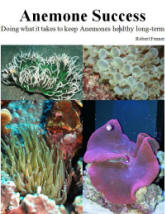|
FAQs on Long Tentacle Anemone
Nutritional Disease/Health
Related Articles: LTAs, Anemones,
Bubble
Tip Anemones, Cnidarians, Coldwater Anemones, Colored/Dyed Anemones,
FAQs on LTA Disease:
LTA Health/Disease 1, LTA Hlth./Dis. 2, LTA Hlth./Dis. 3, LTA Hlth./Dis. 4, LTA Hlth./Dis.
FAQs on Anemone Disease by Category:
Diagnosing,
Environmental (Pollution/Poisoning, Lighting...),
Social (Allelopathy...),
Trauma,
Pathogenic (Infectious, Parasitic, Viral)
Predatory/Pest, Treatments
LTA Reproduction ,
Related FAQs:
LTA Health/Disease
1, LTA Hlth./Dis. 2, LTA Hlth./Dis. 3, & LTAs 1, LTAs 2, LTA Identification, LTA Behavior, LTA
Compatibility, LTA Selection,
LTA Systems, LTA Feeding, & LTA Reproduction,
|
ALL chemo-photosynthetic life NEEDS measurable
nutrients, INCLUDING Nitrate and soluble Phosphate. W/O these, they will
wither and die. BEWARE the use of chemical filtrants
Photosynthetic by day; filter out small zooplankters
by night... or small proffered items by you
|
 |
New Print and
eBook on Amazon:
Anemone Success
Doing what it takes to keep Anemones healthy long-term
by Robert (Bob) Fenner
|
LTA behavior, health, systems 2/2/06 Hi guys!
wonderful site, great advice! Like many before me and
very unfortunately many after me in July 2005 I made an impulse
purchase, I purchased a long tentacle anemone. Everything was fine till
about a month ago. Here are parts "article" I wrote for my
website (to read it all www.homereefkeeping.com) it will explain my
predicament: <Thank you for this> We bought an anemone in July of
2005. We got our Long Tentacle Anemone (LTA with a bright red stock)
along with 2 True Percula Clownfish. The first mistake we made was not
researching anemones and finding out how to care for them prior to
making our purchase. Our second mistake was buying it on impulse.
<Very common> It lived in it's cave for a while it would
expand and half went from a pale cream color to a 'dusky pink',
the other half being sheltered from the bright metal halides stayed the
pale cream color. In mid October it moved from the cave to an opening
in the rock on the left hand side of the tank. It would expand to the
size of a typical dinner plate. We would feed it medium/large sized
(about 1/3 of a shrimp) pieces of raw, thawed shrimp every 5 days or
so.. It would take the food readily, fold back on itself, and would
ingest the food given. The entire anemone turned a healthy 'dusky
pink' <Yes... thank goodness energy/food provided by you through
feeding... inadequate light response> Today's date is January
28, 2006 and since December (unfortunately I did not keep records, or
dates) the anemone had been acting 'strange' for the last
month. It would no longer expand fully, it had become difficult to
feed, would retract on itself. It hasn't completely lost it's
color. <Yes, bleaching...> Approximately 5 days ago the anemone
'fell' through the rocks, for about a day it hid under the
rockwork; 3 days ago it moved to the back of the tank where it has been
laying on its side. I thought it had died and tried to move it only to
find out that it has attached itself solidly onto one of the rocks.
For
the last 2 days I've been feeding the anemone shrimp (that I put
through the blender) and Mysis with a turkey baster. Here's where
opinion vary; where I had read to feed the anemone large meaty chunks,
on another site it said to feed it small shredded pieces of
'meat'. After a bit of consideration and seeing what we'd
been through with our anemone I am most certainly starting to think
that the shredded option makes a lot of sense. If you feed pieces of
food that are too large the anemone cannot digest them and slowly
expels the food. Thus making the anemone slowly starve, and all the
while you think you've been feeding it. <Mmm, as long as the
food is taken, ingested...> Well we are now Jan 31st, the anemone
has gone back under rocks where I can't get to it's mouth, it
inflated it's stock huge today and seemed the have some kind of
line down the middle, now (4hrs later) it's slowly deflated itself.
yesterday I saw its oral cavity and it was huge, much bigger than
I'd ever seen it, today I can't see it so I don't know.
Because it's under rocks I can't tell for the life of me if
it's splitting, dying or just taking me for a ride on a nasty
roller coaster (worried it's dying, then it looks "ok"
then it disappears) Has anyone ever seen an anemone split? <Oh
yes> How does it act before splitting? <Sometimes "out of
the ordinary"... often not> what else could be wrong with it?
<... a lack of light, circulation, metabolite poisoning, a dearth of
biomineral, alkalinity...> I have a 65 gallon tank, 80lbs of Live
sand, 120lbs of LR, a galaxy coral, a frogspawn coral, <... Oh, and
allelopathy... chemical competition. These animals are problematic in
the same water> 2 true Percs, a lawnmower blenny, 2 cleaner shrimp,
scarlet crabs, blue legged crabs and an assortment of snails. The
shrimp molt almost every 2 weeks. My water parameters are as follows :
ammonia: 0, nitrite: 0 nitrate:0 phosphates:0-0.5 (gha prob...) ph: 8.0
to 8.3 depending on the time of day, temp: 79F salinity: 1.025 other
than a drop in phosphates the water has been stable since it cycled in
May 2005 I have a protein skimmer, 3 powerheads, a PhosBan/ROWAphos
fluidizer (long cylindrical thing for active carbon and phosphate
remover) up until 3 days ago had a Eheim canister filter (stopped it to
see if it was the cause of high phosphates and my phosphates have
dropped from 0.5 to 0) Thank you for all your help Catherine <Needs
to be in a different system (w/o the Oculinid, Euphylliid) and more
light... at least. Bob Fenner>
|
|

